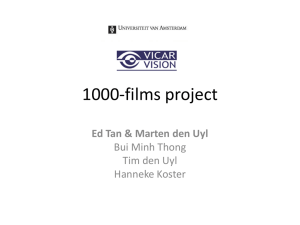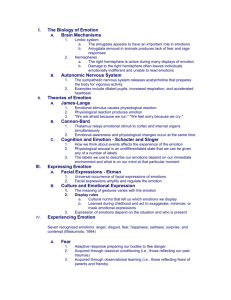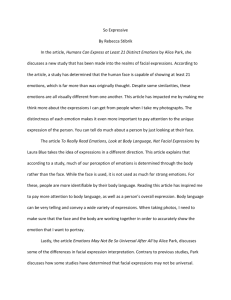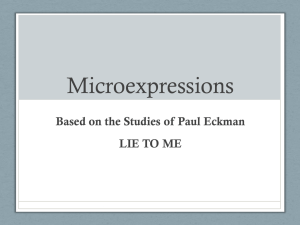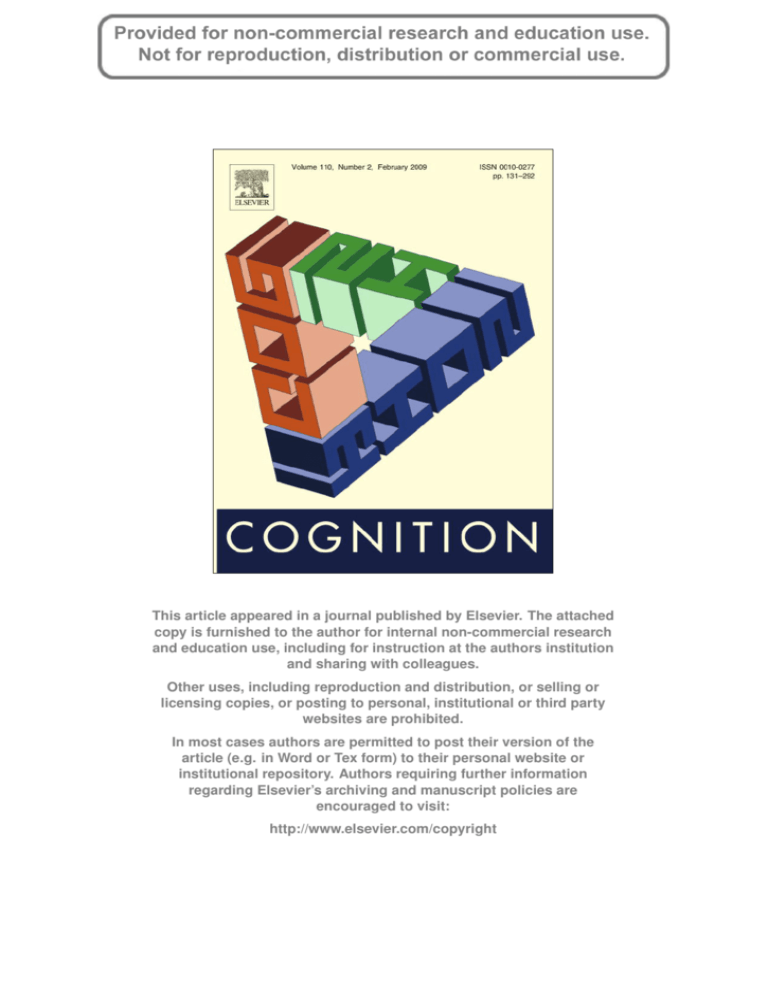
This article appeared in a journal published by Elsevier. The attached
copy is furnished to the author for internal non-commercial research
and education use, including for instruction at the authors institution
and sharing with colleagues.
Other uses, including reproduction and distribution, or selling or
licensing copies, or posting to personal, institutional or third party
websites are prohibited.
In most cases authors are permitted to post their version of the
article (e.g. in Word or Tex form) to their personal website or
institutional repository. Authors requiring further information
regarding Elsevier’s archiving and manuscript policies are
encouraged to visit:
http://www.elsevier.com/copyright
Author's personal copy
Cognition 110 (2009) 242–247
Contents lists available at ScienceDirect
Cognition
journal homepage: www.elsevier.com/locate/COGNIT
Brief article
Development of perceptual expertise in emotion recognition
Seth D. Pollak a,*, Michael Messner a, Doris J. Kistler b, Jeffrey F. Cohn c
a
Department of Psychology and Waisman Center, University of Wisconsin at Madison, 1500 Highland Avenue, Madison, WI 53711, USA
University of Louisville, The Heuser Hearing Institute,117 E. Kentucky Street, Louisville, KY 40203, USA
c
University of Pittsburgh, 4327 Sennott Square, Pittsburgh, PA 15260, USA
b
a r t i c l e
i n f o
Article history:
Received 23 March 2007
Revised 29 September 2008
Accepted 3 October 2008
Keywords:
Emotion perception
Face processing
Effects of experience
Developmental plasticity
Child abuse
Emotion recognition
Perceptual expertise
Learning
a b s t r a c t
How do children’s early social experiences influence their perception of emotion-specific
information communicated by the face? To examine this question, we tested a group of
abused children who had been exposed to extremely high levels of parental anger expression and physical threat. Children were presented with arrays of stimuli that depicted the
unfolding of facial expressions, from neutrality to peak emotions. The abused children
accurately recognized anger early in the formation of the facial expression, when few physiological cues were available. The speed of children’s recognition was associated with the
degree of anger/hostility reported by the child’s parent. These data highlight the ways in
which perceptual learning can shape the timing of emotion perception.
Ó 2008 Elsevier B.V. All rights reserved.
1. Introduction
Humans rely heavily on facial expressions when rapidly
communicating emotional states to others. Although considerable attention has been devoted to how the nervous
system responds to faces as compared with other objects,
there are still many questions about factors that affect
the perception of emotion-specific information communicated by the face. This experiment addresses how the perception of affective signals is influenced by children’s early
perceptual and social experiences. The findings suggest
that perceptual learning influences emotion perception,
and that social experience has an important role in calibrating properties of emotion perception according to the
frequency or salience of affective expressions populating
an individual’s environment.
Physical differences between facial expressions are
small compared with the range of variation in many clas* Corresponding author. Tel.: +1 608 890 2525; fax: +1 608 890 2424.
E-mail addresses: spollak@wisc.edu (S.D. Pollak), doris.kistler@louisville.edu (D.J. Kistler), jeffcohn@pitt.edu (J.F. Cohn).
0010-0277/$ - see front matter Ó 2008 Elsevier B.V. All rights reserved.
doi:10.1016/j.cognition.2008.10.010
ses of non-face objects. Yet young infants are sensitive to
the subtle differences distinguishing facial expressions of
emotion (Bornstein & Arterberry, 2003; Montague &
Walker-Andrews, 2001). Debate continues about whether
the human brain has a specialized neural subsystem for
face perception (Farah, Wilson, Drain, & Tanaka, 1998;
Kanwisher, 2000; Moscovitch, Winocur, & Behrmann,
1997) or whether these neural systems are developed
through extensive expertise with faces (Diamond & Carey,
1986; Gauthier & Tarr, 1997). In either case, it is clear that
over the course of development, perceptual learning involves interactions between areas involved in face recognition and those involved in spatial attention, feature
binding and memory recall (Dolan et al., 1997). In addition,
experience from other modalities, such as auditory information, likely contributes to children’s understanding of
facial expressions.
Several studies have demonstrated pronounced effects
of visual experience on subsequent perceptual performance. The range of approaches used to address this issue
includes low-level retinotopically specific effects (McKee &
Westheimer, 1978) and single-unit recordings of inferior
Author's personal copy
S.D. Pollak et al. / Cognition 110 (2009) 242–247
temporal cortex (Fink et al., 1996; Heinze et al., 1994) to
higher-order changes in object encoding (Carey & Diamond,
1994) and effects of culture (Elfenbein & Ambady, 2003).
These data suggest that changes in categorization and
automatization of perceptual processing occur based upon
practice with specific classes of objects (Gauthier, Skudlarski,
Gore, & Anderson, 2000; Tanaka, Curran, & Sheinberg, 2005).
Such perceptual learning effects may also hold true for
facial expressions of emotion.
Extant research suggests that the neural mechanisms
underlying face perception can be altered by previous
experience with faces (Leopold, O’Toole, Vetter, & Blanz,
2001; Rhodes, Jeffery, Watson, Clifford, & Nakayama,
2003; Webster, Kapling, Mizokami, & Duhamel, 2004;
Webster & Maclin, 1999; Zhao & Chubb, 2001). Less is
known about perception of discrete emotions. We are all
exposed to facial expressions of emotion that are, in many
ways, quite similar, making it difficult to evaluate the role
of experience in the organization of emotion processing
systems. Adults perceive basic emotional expressions as
belonging to discrete categories (Young et al., 1997). In
prior research we found that young children perceive emotional expressions based upon similar categories, but
abused children–who have experienced frequent displays
of extreme hostility–display broader perceptual categories
of anger (but not other emotions) relative to nonmaltreated children (Pollak & Kistler, 2002). We also found that
abused children could accurately identify angry faces
based upon less perceptual information than typically
developing children (Pollak & Sinha, 2002). These experiments suggest a role for perceptual learning in emotional
development. However, most studies that examine the
perception of emotional expressions in the face use static
images that represent peak emotional expressions or morphed artificial images to approximate facial movement.
Such stimuli carry important advantages including valid
measurement of the emotion being conveyed. The emotional stimuli that children experience during interpersonal interactions are dynamic rather than static.
Therefore, the present experiment was designed to test
whether a feature of perceptual learning of emotions involves the ability to formulate valid predictions about
changes in facial musculature during early stages of the
formation emotional expressions.
Generating emotional expressions requires sequenced
movements of facial muscles (Ekman & Friesen, 1978).
One hypothesis is that to correctly identify an emotion,
observers use early information from these muscle movements to generate hypotheses about what emotion is being
displayed. Once those characteristic movements have been
extracted and mapped onto emotion categories, they provide additional social information. Therefore, rapid recognition of emotional signals facilitates adaptive social
functioning. Observers integrate form and motion into
judgments about facial information. This process appears
to be guided by the observers’ expectations, perceptual
sensitivity, and mental representations of emotional
knowledge and previous experience/exposure (Knappmeyer, Thornton, & Bulthoff, 2003; see also O’Toole, Roark, &
Abdi, 2002 for discussion).
243
In this study, we examine whether perceptual learning
can shape the dynamics of emotion perception. To do so,
we evaluated whether variations in social experience affect
the perceptual judgments that observers made while viewing the realistic unfolding of human emotional expressions. It is not possible to experimentally manipulate an
individual’s prior knowledge of basic facial expressions.
Therefore, we tested children whose experiences with the
communication of emotion may deviate in important ways
from societal norms: children who had been severely physically maltreated by their parents. This is a population
known to experience perturbations in both the frequency
and content of their emotional interactions with caregivers
as compared with children from nonmaltreating families
(Pollak, 2008; U.S. Department of Health and Human Services, 2004). Reasoning that physically abusive episodes
are likely marked by salient displays of anger, we predicted
that abused children would begin to accurately recognize
angry facial expressions earlier in the dynamic unfolding
of the expression, reflecting a form of perceptual expertise
in emotion recognition. However, because there is no a priori reason to believe that the information processing of
these children generally differs from other children, we
did not predict group differences in recognition processes
for other emotional expressions. In sum, we expected that
the effects of these children’s experiences would be reflected in a specific perceptual adaptation to the dynamics
of expressions of anger.
2. Method
2.1. Participants
Ninety-five 9-year-old children participated in this
experiment. Of these, 49 were physically abused (mean =
9.48 years, sd = 1.5 months; 45% non-Caucasian, 49% female). The comparison group included 46 children (mean
= 9.50 years, sd = 1.6 months; 48% non-Caucasian, 50% female). An additional 80 adults and 80 9-year-old children
participated in a preliminary study (described below) to
rate the facial stimuli. None of the 160 individuals who
participated in the rating studies were included in the perceptual experiment. Physically abused and non-abused
comparison children were screened first through the registry of state Child Protective Services records for abuse histories and then in our laboratory with the Parent–Child
Conflict Tactics Scale (Straus, Hamby, Finkelhor, Moore, &
Runyan, 1998), a measure of the extent to which a parent
has carried out specific acts of physical aggression toward
the child. Non-abused comparison families were recruited
from the community. Abused and control children had
similar psycho-demographic characteristics: parents from
both groups were unskilled/semi-skilled workers or were
skilled manual workers. All children had normal or corrected-to-normal vision. To further support the claim that
abused children develop within environments marked by
higher levels of anger, parents completed the State-Trait
Anger Expression Inventory (Spielberger, 1988), a self-report measure of subjective experiences and expression of
anger.
Author's personal copy
244
S.D. Pollak et al. / Cognition 110 (2009) 242–247
2.2. Stimuli
Image data were from the Cohn–Kanade Facial Expression Database (Kanade, Cohn, & Tian, 2000), in which posers
were video-recorded while performing directed facial action tasks (Ekman, 2007). These included both single facial
actions (e.g., lowering the brows) and facial actions associated with displays of specific emotions. Image sequences
were filmed using a frontal camera and digitized from SVHS video into 640 480 pixel arrays with 24-bit color resolution. Each sequence begins with a neutral expression
and ends with the target actions. For the present study,
we selected four sequences for each of five emotions. No
poser appeared in more than one sequence. The sequences
varied slightly in duration, with a mean of 19.85 frames
(0.66 s) and standard deviation of 7.91 frames (0.26 s). To
provide uniform duration, these video segments were
down-sampled to 10 frames reflecting, respectively, 5, 11,
16, 20, 36, 59, 69, 75, 83, and 90% of the percentage of the
elapsed sequence from absent-to-peak emotional expression. The final data set consists of twenty different models,
selected to represent both genders and several ethnicities,
posing five emotions: angry, happy, fear, sad, and surprise.
Twenty-five percent of the models posing each emotion
were non-Caucasian and children’s performance was not
influenced by the relationship between the race of the model in the stimulus and the race of the child, all ps >2.
Images from the video sequences were validated using
multiple methods. First, two trained FACS coders independently scored each one. Second, two groups of adults completed a recognition task in which they labeled each
sequence using either forced-choice or free response formats. Third, two groups of typically developing 7–12
year-old children did the same, labeling each sequence
using either forced-choice or free response formats. A
forced-choice labeling format was used so that the data
could be directly compared to the ratings of Ekman and
Friesen (1977) and a free response rating was used to provide more stringent recognition criteria (Widen & Russell,
2003). These data are summarized in Table 1.
2.3. Procedure
Each child viewed five emotions, each posed by four different models. Each emotion was presented as a series of
ten images beginning with a neutral emotional expression
through the peak expression (Fig. 1). Thus, each child responded to 200 total trials (5 emotions 4 posers per
emotion 10 images per poser). Each image was presented for three seconds. Children were instructed to
determine what emotion each model was feeling after
hearing what was whispered into his/her ear. Children
made forced-choice responses on a touch screen monitor
after each image, selecting among: nothing yet, happy,
sad, angry, afraid, or surprised. Presentation of each emotion was randomized across participants.
3. Results
Our analyses test how early in the unfolding of emotional expressions children accurately recognize an emotional expression. The time course of identification for
each emotion was assessed by fitting group identification
functions relating the probability of identification to the
percentage of the elapsed emotion sequence (neutral
through peak). The data were collapsed across models posing the expressions since there were no group differences
for the models. Functions were fit to a Weibull distribution
in MATLAB using a publicly available algorithm
(Wichmann & Hill, 2001) following the approach used in
Pollak and Kistler (2002). These functions are displayed
in Fig. 2; the identification thresholds, defined as the image
value corresponding to an identification probability of .5,
and the 95% confidence intervals are indicated on each
function. A repeated measures analysis of variance revealed a main effect of Emotion, F(4, 90) = 66.98,
p < 0.001, gp2 = 0.4 19. This effect was further qualified
by an interaction of emotion maltreatment group image F(36, 3348) < 0.005, gp2 = 0.0 24. Anger tended to be
identified earlier by the abused children (control M = 5.3,
SE = 0.22; abused M = 4.7, SE = 0.21, p = 0.06, gp2 = 0.0
37). The groups did not differ in recognizing other emotions, identifying happy (control M = 7.0, SE = 0.16; abused
M = 7.0, SE = 0.15, p = 0.94) and sad (control M = 5.7,
SE = .25; abused M = 5.7, SE = .24, p = 0.96) expressions earlier than fearful (control M = 3.8, SE = 0.21; abused M = 3.9,
SE = 0.20, p = 0.74) and surprised (control M = 4.6, SE = .20;
abused M = 4.8, SE = 0.19, p = 0.60) expressions. Analyses of
children’s response errors indicated that neither group
showed a response bias for selecting any particular emotion, F(4, 372) = 1.14, n.s.
An ancillary issue concerns the difficulty in measuring
children’s emotional environments. To address this issue,
we asked parents directly about the frequency and severity
of the ways in which they discipline their children using
the Conflict Tactics Scale. As expected, all of the non-abusive families scored less than 10 on this measure, reflecting
verbal approbations and occasional and mild corporal punishment. In contrast, abusive families scored between 20–
77, reflecting frequent and severe actions that include
Table 1
Stimulus validation: proportion of child and adult subjects (from four independent samples) who agreed on the target emotion in preliminary studies.
Adult
Happy
Surprise
Fear
Sadness
Anger
Child
Forced-choice (N = 40)
Free-response (N = 40)
Forced-choice (N = 40)
Free-response (N = 40)
1.00
0.98
0.88
0.92
0.93
0.99
0.95
0.65
0.86
0.69
0.97
0.88
0.67
0.91
0.81
0.91
0.65
0.52
0.82
0.81
Author's personal copy
S.D. Pollak et al. / Cognition 110 (2009) 242–247
245
Fig. 1. Examples from the stimulus array for (top to bottom) models creating scared, sad, happy, surprised, and angry facial expressions.
harsh physical discipline, choking, scalding, and realistic
threats to injure or abandon the child. Groups differed
(control M = 2.5, SD = 2.7; abused M = 40.0, SD = 16.6) in
this regard, F(1,94) = 229.1, p < 0.001. While parents are
likely to under-report abusive behavior on these measures,
it is unlikely that parents would systematically over-report
these kinds of behaviors. Finally, because our hypotheses
involved children’s experience perceiving anger, we asked
parents to complete the State-Trait Anger Expression
Inventory. Parents did not differ in their reports of state anger- that is, a measure of how they were feeling at the moment (control M = 45.4, SD = 3.5; abused M = 46.3,
SD = 5.2). However, abusive parents reported more trait
anger—that is, how generally they feel and overtly express
anger (control M = 43.9, SD = 4.8; abused M = 55.1,
SD = 13.5), F(1,92) = 28.01, p < 0.001. Parent trait anger
was associated with more abusive acts towards children,
r = 0.35, p = 0.001, d = 0.71, and children whose parents reported more abusive behaviors demonstrated more perceptual sensitivity to angry faces, r = 0.23, p = 0.03,
d = 0.48.
4. Discussion
The present experiment examined children’s construction of emotion representations from fragmentary or partial information as models generated naturalistic facial
expressions. We found that children who have been exposed to unusually high levels of anger were able to accurately recognize anger early in the formation of the facial
expression of anger, when fewer expressive cues (such as
activation of facial musculature) were available. However,
these children performed similarly to controls when viewing other emotional expressions, suggesting that the
abused children neither had a bias to select anger nor that
the abused group generally performed or understood the
task differently than did controls. These data address both
basic issues about the development of emotion perception
and also applied issues about the mechanisms through
which child abuse is associated with behavioral problems
in children.
4.1. Perceptual learning and emotion
It is difficult to precisely measure the role of social
experience on the organization of developing perceptual
systems (Pollak, in press). Within seconds of post-natal life,
the human infant experiences a wealth of emotional input:
sounds such as coos, laughter, tears of joy; sensations of
touch, hugs, restraints, soothing and jarring movements;
blurred images of faces with smiles, wide eyes; and a host
of smells including pheromones. After a few days, let alone
after months or years, it becomes a significant challenge to
quantify an individual’s emotional experiences. Almost instantly, the maturation of the brain has been confounded
by experiences with emotions. To address this problem,
we tested children who have experienced social environments that are marked by high levels of anger and hostility. The features that make their environments atypical
serve as approximations of how environmental variations
in experience may affect development. The present data
suggest that variations in experience with emotional facial
expressions can induce different perceptual processing
strategies and influence how and when emotions are perceived. Our stimuli were designed to capture naturalistic
unfolding of emotional expressions, which resulted in anger expressions involving lip tightening rather than the
open-mouthed expressions associated with shouting. It is
Author's personal copy
246
S.D. Pollak et al. / Cognition 110 (2009) 242–247
plays. Future research might explore whether abused
children may be particularly adept at detecting suppressed
anger expressions as well.
It has been proposed that experience-independent neural structures facilitate attention to face-like objects, and
such stimulus preferences lead to increased learning
based on experience or create cortical specialization for
face processing (For discussion, see Nelson, 2001; Pascalis
et al., 2005; Tarr & Gauthier, 2000). Similar processes
might also underlie emotion perception. Our results are
consistent with theories that perception is a conjoint function of current sensory input interacting with memory and
attentional processes (Kosslyn, 1996; Treisman, 1988),
specifically, that memory and attention organize visual
input through selective effects on emotion processing.
Brain mechanisms appear to learn to perceive and discriminate stimuli on the basis of acquired behavioral significance. This suggests that perceptual learning involves
both category-specific extrastriate neuronal populations
and interactions with higher-order brain regions including
circuitry of the amygdala, fusiform, lateral parietal cortex,
and higher-order visual regions that coordinate this sort of
high level perception (Dolan et al., 1997; Pegna, Khateb,
Lazeyras, & Seghier, 2005).
1
Angry
Judged (%)
0.8
0.6
0.4
Control
Abused
0.2
0
1
Sad
Judged (%)
0.8
0.6
0.4
0.2
0
1
Fear
Judged (%)
0.8
4.2. Perceptual learning and psychopathology
0.6
0.4
0.2
0
1
Happy
Judged (%)
0.8
0.6
0.4
0.2
0
1
Surprise
Judged (%)
0.8
0.6
0.4
0.2
0
0
20
40
60
80
100
Image (%)
Fig. 2. Recognition functions of abused and control children for facial
displays as a function of percent of peak emotional expression.
possible that abused children may be even better at detecting expressions of anger involving overt, open mouth dis-
Adaptation to their environments, in the form of perceptual learning, likely facilitates children’s efficient coding of important stimulus features from the social
environment. How might environmental deviation—such
as extremely hostile affective experiences—calibrate the
processes related to emotion perception? The development
of increased perceptual sensitivity for the fine-grained details of variation in affective expressions may provide a
behavioral advantage for children living in threatening
contexts, allowing earlier identification of salient emotions. Anger-related cues may become especially salient
to physically abused children because they are associated
with imminent harm. Early identification of an emotion
on the basis of minimal visual information, if accurate,
would be adaptive for physically abused children, therefore they may learn to make decisions about the signaling
of anger using minimal visual information. This does not
suggest that there is anything inherently problematic or
unhealthy about anger; on the contrary, the argument is
simply that children learn to use highly predictive signals
through increased attention to minimal signals. In this
manner, maltreatment may sensitize children to certain
emotional information that may be adaptive in abusive
contexts but maladaptive in more normative interpersonal
situations (Pollak, 2008).
The present data highlight the important function of facial expressions in the social communication of changes in
affective states. Much less is understood about how humans learn to process the temporal affective cues integral
to real-life social exchanges. It appears that children who
have experienced direct physical harm become sensitive
to the social signals of anger. The implication of this finding
is that the social relevance of facial movements affects processing and recognition of emotional expressions.
Author's personal copy
S.D. Pollak et al. / Cognition 110 (2009) 242–247
References
Bornstein, M. H., & Arterberry, M. E. (2003). Recognition, discrimination
and categorization of smiling by 5-month-old infants. Developmental
Science, 6, 585–599.
Carey, S., & Diamond, R. (1994). Are faces perceived as configurations
more by adults than by children? Visual Cognition, 1, 174–253.
Diamond, R., & Carey, S. (1986). Why faces are and are not special: An
effect of expertise. Journal of Experimental Psychology: General, 115,
107–117.
Dolan, R. J., Fink, G. R., Rolls, E., Booth, M., Holmes, A., Frackowiak, R. S. J.,
et al (1997). How the brain learns to see objects and faces in an
impoverished context. Nature, 389, 596–599.
Ekman, P. (2007). The directed facial action technique. In J. A. Coan & J. B.
Allen (Eds.), The handbook of emotion elicitation and assessment, Oxford
University press series in affective science (pp. 47–53). New York, NY:
Oxford University.
Ekman, P., & Friesen, W. V. (1977). Manual for the facial action coding
system. Palo Alto: Consulting Psychologists Press.
Ekman, P., & Friesen, W. V. (1978). Facial action coding system: A technique
for the measurement of facial movement. Palo Also: Consulting
Psychologists Press.
Elfenbein, H. A., & Ambady, N. (2003). Universals and cultural differences
in recognizing emotions of a different cultural group. Current
Directions in Psychological Science, 12, 2003.
Farah, M. J., Wilson, K. D., Drain, M., & Tanaka, J. N. (1998). What is
‘‘special” about face perception? Psychological Review, 105, 482–498.
Fink, G. R., Halligan, P. W., Marshall, J. C., Frith, C. D., Frackowiak, R. S. J., &
Dolan, R. J. (1996). Where in the brain does visual attention select the
forest and trees? Nature, 382, 626–629.
Gauthier, I., Skudlarski, P., Gore, J. C., & Anderson, A. W. (2000). Expertise
for cars and birds recruits brain areas involved in face recognition.
Nature Neuroscience, 3, 191–197.
Gauthier, I., & Tarr, M. J. (1997). Becoming a ‘‘Greeble” expert: Exploring
mechanisms of face recognition. Vision Research, 37, 1673–1682.
Heinze, H. J., Magnun, G. R., Burchert, W., Hinrichs, H., Scholz, M., Munte,
T. F., et al (1994). Combined spatial and temporal imaging of brain
activity during visual selective attention in humans. Nature, 372,
543–546.
Kanade, T., Cohn, J., Tian, Y. (2000). Comprehensive database for facial
expression analysis. In Proceedings of the fourth IEEE international
conference on automatic face and gesture recognition (pp. 46–53).
Kanwisher, N. (2000). Domain specificity in face perception. Nature
Neuroscience, 3, 759–763.
Knappmeyer, B., Thornton, I. M., & Bulthoff, H. H. (2003). The use of facial
motion and facial form during the processing of identity. Vision
Research, 43, 1921–1936.
Kosslyn, S. M. (1996). Image and brain: The resolution of the imagery debate.
Cambridge, MA: MIT Press.
Leopold, D. A., O’Toole, A. J., Vetter, T., & Blanz, V. (2001). Prototypereferenced shape encoding revealed by high level aftereffects. Nature
Neuroscience, 4, 89–94.
McKee, S. P., & Westheimer, G. (1978). Improvement in vernier acuity
with practice. Percept Psychophys, 24(3), 258–262.
Montague, D. P. F., & Walker-Andrews, A. S. (2001). Peekaboo: A new look
at infants’ perception of emotion expressions. Developmental
Psychology, 37, 828–838.
Moscovitch, M., Winocur, G., & Behrmann, M. (1997). What is special
about face recognition? Nineteen experiments on a person with
visual object agnosia and dyslexia but normal face recognition.
Journal of Cognitive Neuroscience, 9, 555–604.
Nelson, C. A. (2001). The development and neural bases of face
recognition. Infant and Child Development, 10, 3–18.
247
O’Toole, A. J., Roark, D. A., & Abdi, H. (2002). Recognizing moving faces: A
psychological and neural synthesis. Trends in Cognitive Sciences, 6,
261–266.
Pascalis, O., Scott, L. S., Kelly, D. J., Dufour, R. W., Shannon, R. W.,
Nicholson, E., et al (2005). Plasticity of face processing in infancy. In
Proceedings of the national academy of sciences, 102, 5297–5300.
Pegna, A. J., Khateb, A., Lazeyras, F., & Seghier, M. L. (2005). Discriminating
emotional faces without primary visual cortices involves the right
amygdala. Nature Neuroscience, 8, 24–25.
Pollak, S. D. (2008). Mechanisms linking early experience and the
emergence of emotions: Illustrations from the study of maltreated
children. Current Directions in Psychological Science, 17, 370–375.
Pollak, S.D. (in press). The emergence of emotion: Experience,
development, and biology. In M.R. Gunnar & D. Cicchetti (Eds.),
Meeting the challenges of translational research in child psychology: 35th
Minnesota symposium on child psychology. New York: Wiley.
Pollak, S. D., & Kistler, D. J. (2002). Early experience is associated with the
development of categorical representations for facial expressions of
emotion. In Proceedings of the national academy of sciences of the united
states of America, 99(13), 9072–9076.
Pollak, S. D., & Sinha, P. (2002). Effects of early experience on children’s
recognition of facial displays of emotion. Developmental Psychology,
38, 784–791.
Rhodes, G., Jeffery, L., Watson, T. L., Clifford, C. W. G., & Nakayama, K.
(2003). Fitting the mind to the world: Face adaptation and
attractiveness aftereffects. Psychological Science, 14, 558–566.
Spielberger, C. (1988). State-trait anger expression inventory, research
edition. Odessa, Florida: Professional Manual. Psychological
Assessment Resources.
Straus, M. A., Hamby, S. L., Finkelhor, D., Moore, D. W., & Runyan, D.
(1998). Identification of child maltreatment with the parent-child
conflict tactics scales: Development and psychometric data for a
national sample of American parents. Child Abuse & Neglect, 22(4),
249.
Tanaka, J. W., Curran, T., & Sheinberg, D. L. (2005). The training and
transfer of real-world perceptual expertise. Psychological Science, 16,
145–151.
Tarr, M. J., & Gauthier, I. (2000). FFA: A flexible fusiform area for
subordinate-level visual processing automatized by expertise. Nature
Neuroscience, 3(8), 764–769.
Treisman, A. (1988). Features and objects. Quarterly Journal of
Experimental Psychology, 40, 201–237.
U.S. Department of Health and Human Services, Health Resources and
Services Administration, Maternal and Child Health Bureau. (2004).
Child health USA 2004. Rockville, Maryland: U.S. Department of Health
and Human Services.
Webster, M. A., Kapling, D., Mizokami, Y., & Duhamel, P. (2004).
Adaptation to naturalistic facial categories. Nature, 428, 557–561.
Webster, M. A., & Maclin, O. H. (1999). Figural aftereffects in the
perception of faces. Psychonomic Bulletin and Review, 6, 647–653.
Wichmann, F. A., & Hill, N. J. (2001). The psychometric function: I. Fitting,
sampling and goodness-of-fit. Perception and Psychophysics, 63,
1293–1313.
Widen, S. C., & Russell, J. A. (2003). A closer look at preschoolers’ freely
produced labels for facial expressions. Developmental Psychology, 39,
114–128.
Young, A. W., Rowland, D., Calder, A. J., Etcoff, N. L., Seth, A., &
Perrett, D. (1997). Facial expression megamix: Tests of
dimensional and category accounts of emotion recognition.
Cognition, 63, 271–313.
Zhao, L., & Chubb, C. (2001). The Size-tuning of the face-distortion
aftereffect. Vision Research, 41, 2979–2994.




